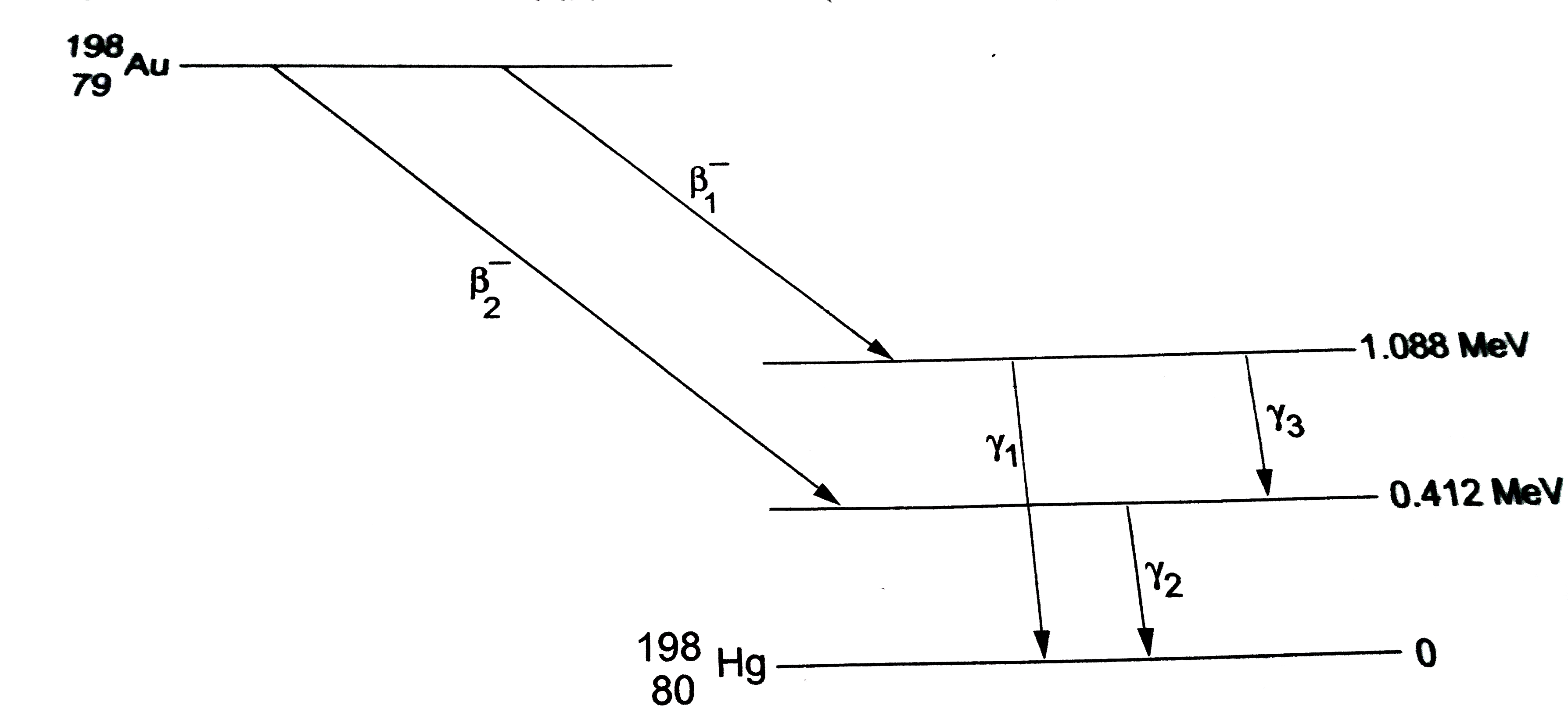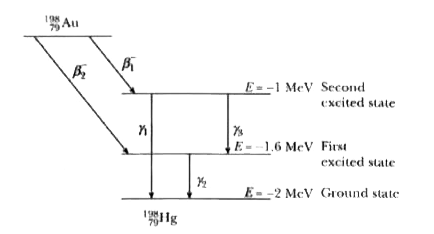Consider the beta decay
^198Au→198Hg∗+Bη−1+→v.
where ^198Hg∗ represents a mercury nucleus in an excited state at energy 1.088MeV above the ground state. What can be the maximum kinetic energy of the electron emitted? The atomic mass of ^198Au is 197.968233u and that of ^198Hg is 197.966760u.Solution in Tamil
If the product nucleus ^198Hg is formed in its ground state, the kinetic energy available to the electron and the antineutrino is
Q=[m(^198Au)−m(^198Hg)]c2.
As ^198Hg∗ has energy 1.088MeV more than ^198Hg in ground state, the kinetic energy actually available is
Q=[m(^198Au)−m(^198Hg)]c2−1.088MeV
=(197.968233u−197.966760u)(931MeVu−1
−1.088MeV
=1.3686MeV−1.088MeV=0.2806MeV
This is also the maximum possible kinetic energy of the electron emitted.
Topper's Solved these Questions
- THE NUCLEOUSBOOK - HC VERMACHAPTER - THE NUCLEOUSEXERCISE - Short answer
12 Videos
- THE NUCLEOUSBOOK - HC VERMACHAPTER - THE NUCLEOUSEXERCISE - Objective 1
19 Videos
- THE NUCLEOUSBOOK - HC VERMACHAPTER - THE NUCLEOUSEXERCISE - Exercise
53 Videos
- SPEED OF LIGHTBOOK - HC VERMACHAPTER - SPEED OF LIGHTEXERCISE - Exercises
3 Videos
- THE SPECIAL THEORY OF RELATIVITYBOOK - HC VERMACHAPTER - THE SPECIAL THEORY OF RELATIVITYEXERCISE - Exercise
28 Videos
Similar Questions
If neutrons exert only attractive force, why don't we have a nucleus containing neutrons alone?
View SolutionThe mass of a neutral carbon atom in ground state is
View SolutionAssume that the mass of a nucleus is approximately given by M=Ampwhere A is the mass number.Estimate the density of matter in kgm−3inside a nucleus.
View SolutionIn an experiment to measure the speed of light by Fizeau's apparatus, following data are used :
Distance between the mirrors = 12.0 km,
Number of teeth in the wheel = 180.
Find the minimum angular speed of the wheel for which the image is not seen.
View SolutionThe guru of a yogi lives in a Himalyan cave, 1000 km away from the house of the yogi . The yogi claims that whenever he thinks about his guru, the guru immediately knows about it. Calcualte the minimum possible tiem interval between the yogi thinking about the guru and the guru knowing about it.
View SolutionThe half-life of ^198Au is 2.7days. Calculate (a) the decay constant, (b) the average-life and (C ) the activity of 1.00mg of ^198Au. Take atomic weight of ^198Au to be 198gmol−1.
View Solution1g of .79Au198(t1/2=65hr) decays by β-emission to produce stable Hg.
a. Write nuclear reaction for process.
b. How much Hg will be present after 260 hr.
View SolutionGold ._(79)^(198)Au undergoes beta^(-) decay to an excited state of ._(80)^(198)Hg . If the excited state decays by emission of a gamma -photon with energy 0.412 MeV , the maximum kinetic energy of the electron emitted in the decay is (This maximum occurs when the antineutrino has negligble energy. The recoil enregy of the ._(80)^(198)Hg nucleus can be ignored. The masses of the neutral atoms in their ground states are 197.968255 u for ._(79)^(198)Hg ).
View SolutionObtain the maximum kinetic energy of β-particles, and the radiation frequencies of γ decays in the decay scheme shown in Fig. 14.6. You are given that m(.198Au)=197.968233u,m(.198Hg)=197.966760u

View Solutionनीचे दी गई क्षय योजना में γ क्षयों की विकिरण आवृत्तियां एवं β कणों की अधिकतम गतिज ऊर्जाएं ज्ञात कीजिए। दिया है
m(.198Au)=197.968233u
m(.198Hg)=197.966760u

View Solutionनीचे दी गयी क्षय योजना ( decay scheme ) में β - कणो की अधिकतम गतिज उर्जाएँ था γ - कानो की विकिरण आवृत्तियाँ (radiation frequencies ) ज्ञात करे |

दिया गया है :m(19879Au)=197.968233 u
m(19880Hg)=197.966760u .
View SolutionObtain the maximum kinetic energy of β- particle and the radiation frequencies corresponding to γ− decays in the figure given below. (rest mass of au -198.968233 u and r.m. of Hg=198=197.966760 u)
View Solution80Hg198+X→79AU198+1H1என்ற வினையில் X என்பது
View SolutionGold nucleus (""_(79)^(198)Au) can decay into mercuyr nucleus (""_(80)^(198)Hg^(8)) by two decay schemes shown in figure below (i) it can emit a beta -particle (beta_(1)) and come to ground state by either emiting one gamma - ray ( gamma_(1) ) or emitting two gamma - rays ( gamma_(3) and gamma_(4) ) (ii) It can emit one beta - particle (beta_(2)) and come to ground state by emitting gamma_(2) ray. Atomic masses: ""^(198)Au=197.9652 amu and ""^(198)Hg=197.9662 amu. Given that 1 amu= 930MeV//c^(2) . The energy levels of the nucleus are shown in figure below Whatis the maximum kinetic energy of emitted beta_(2) particle?
View SolutionGold nucleus (19879Au) can decay into mercuyr nucleus (19880Hg8) by two decay schemes shown in figure below (i) it can emit a β -particle (β1) and come to ground state by either emiting one γ- ray (γ1) or emitting two γ- rays (γ3 and γ4) (ii) It can emit one β- particle (β2) and come to ground state by emitting γ2 ray. Atomic masses: 198Au=197.9652 amu and 198Hg=197.9662 amu. Given that 1 amu= 930MeV/c2. The energy levels of the nucleus are shown in figure below

What is the maximum kinetic energy of emitted β1 parricle ?
View SolutionGold nucleus (19879Au) can decay into mercuyr nucleus (19880Hg8) by two decay schemes shown in figure below (i) it can emit a β -particle (β1) and come to ground state by either emiting one γ- ray (γ1) or emitting two γ- rays (γ3 and γ4) (ii) It can emit one β- particle (β2) and come to ground state by emitting γ2 ray. Atomic masses: 198Au=197.9652 amu and 198Hg=197.9662 amu. Given that 1 amu= 930MeV/c2. The energy levels of the nucleus are shown in figure below

The wavelength of emitted γ - rays is the order
View Solution
